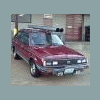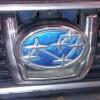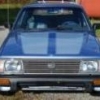Search the Community
Showing results for tags 'carburetor'.
-
Hey guys here with another hitachi carburetor quandary. I feel like I've been up and down these forums for fixing my cars running issue but I cant figure it out. I've got an 88 gl hatch with 150,000 miles that's been sitting for a few years. My Impreza was stolen so I decided to get this thing up a...
-
I'm hoping someone can help me with an issue I am having. I have an 86 brat with the Hitachi Carburetor, I removed the Carburetor and cleaned it and installed a rebuild kit (mainly gasket) every since then when it first starts running it'll idle Really high (3-4000 rpms) then it gets to where it...
- 13 replies
-
- 1
-

-
- brat
- Carburetor
-
(and 1 more)
Tagged with:
-
Hi all, I've been using this forum for the last month to try and figure out for to get my 1983 Brat GL running. I recently rebuilt the Ea81 it came with and swapped the hitachi carb for a Weber (new). There are some rust issues with the car but the engine is in great shape. I've got the engine back...
-
Here's the backstory: The carb I'm currently running on my EA81 in my Coupe I pulled off of an '81 brat in a junkyard along with the manifold. My unit says its a DCP 306-16/304, has manual choke and a vacuum secondary. The venturi sizes are 20/27. The only reference I can find to a carb like that i...
-
Hi Hoping for some help from knowledgable eyes. I have a Subaru GL 87 1.8 Carb. **I recently replaced the overcharging alternator (bad regulator). After timing belt procedure it decided to quit. Overview of this engine- 1. Here is the biggest problem, rear of motor and of alternator area: This...
- 10 replies
-
- hoseselectrical plugs
- vacuum lines
-
(and 5 more)
Tagged with:
-
Hello there fans of the great Subaru ,I have a justy j10, I bought a year I go It wasn't in good condition but I like it ever since I been fixing it up .so far it started from a little fix to a how to become a mechanic . To the point the idle run pure not all cold, runs ok with choke full open and t...
- 1 reply
-
- subaru
- carburetor
-
(and 1 more)
Tagged with:
-
22 degrees forecast for when I plan to start my ‘84 Webered EA81. I have never started this carb in weather so cold. 500 miles from home, with an old battery, also. Any suggestions for a cold weather start?
-
Hello. Having trouble with my electric choke. When the weather is hot i have no problem starting car and driving it around. Problem came when one morning it was a little cooler and engine would not stay on by itself only by playing with the gas pedal. I know this has to do with the cho...
-
I have a weberized 85 Brat with the 3 speed auto transmission. After a couple months I finally got it running. It idles kinda rough and i have to keep the timing fully retarded (literally) or it will stall out, but it does idle. I believe that there are no vacuum leaks so it shouldn't be that. My ma...
-
I have an 85 Brat that I just put a new weber carb on. Problem is when I got the carb mounted up and started it the car immediately went to 5K RPMs and sat there. I checked the throttle wheel and it was ok. I even started the car with the throttle wheel assembly completely unattached from the carb,...
-
I just recently bought an 85 Subaru Brat for 500$, that supposedly only needs a new carburetor. Like most people on here I'm doing a Weber 32/36 swap for it. I don't need to pass an emissions test so I want to get rid of as much unnecessary stuff as I can (EGR, vacuum hoses etc). My question is wha...
-
Hello subaru-gurus, I recently acquired an 86 GL wagon with 230,000 miles. For a few days after I brought it home, on cold starts in the morning it would fire up but idle at a very low RPM. It would stall, and have to be restarted until it seemed to warm-up and then it was fine. Then one day, af...
- 12 replies
-
- fuel pump
- fuel filter
-
(and 1 more)
Tagged with:
-
I have been marooned for months now, living by my wits, doing evertything to save my Subaru Brat and my practical life. I have now succeeded in getting carb rebuilt, replacing water pump & almost a dozen gaskets, and other parts/ewprk/etc. Same problem persists.| Some months ago mechanic rebuilt ca...
-
As the title says... I'm converting to E-85. I need a little help. I've looked around on USMB, but haven found the info i need. (Just a lot of political stuff .) So here's what I know. E-85 has a stoichiometric value (air fuel ratio) of about 9.8 to 1 and Gas is 14.7 to 1. The carburetor meters...
- 3 replies
-
- alternative fuel
- E-85
-
(and 1 more)
Tagged with:
-
I have several factory parts for sale that have been removed from my 1985 Subaru GL Hatchback. Factory Carburetor complete with Air Cleaner, Filter, Hoses, etc. Both Front Turn Signal Assemblies that mount in the bumper Both Front Bumper Energy Absorbers Both Front Marker Light Assemblies Se...
- 1 reply
-
- Carburetor
- wheels
-
(and 2 more)
Tagged with:
-
I got a 1979 Subaru DL today. Unfortunately it is FWD and Automatic, but the price was right!!!!! It is having a couple problem probably from sitting for a year. When I start it it runs at idle for about 2 seconds then screams like I have my foot to the floor! I used a can do carb cleaner, checked t...
- 8 replies
-
- Carburetor
- reving
-
(and 3 more)
Tagged with:
-
Ideas on Swapping a Weber Carburetor on a Subaru EA82 Engine In this Writeup you'll find The Basics: ► A complete installation Guide. ► Solving problems untold by the Manuals. ► Jetting for the EA82 to be used between Sea Level and ~ 6500 Feet (2000 Mts) Altitude. ► Proper rou...
- 10 replies
-
- 2
-

-
- Carburetor
- Adapter Plate
-
(and 8 more)
Tagged with:
-
I recently bought a 1983 DL 4wd wagon ea81 engine, 104 k miles from a dealer with "a bad carburetor that can't be fixed". I got it running smoothly with a can of cleaner and a few tanks of fresh gas w Lucas gas treatment. It still kept stalling at decel and only got 18 mpg, so i bought a carter carb...
-
I've recently narrowed down my car issues to my carburetor. I have a parts Brat so i took that one out and popped it in mine, all the seals are new but it is a different version. And now gas comes of an odd area so i was going to put the old one back in, but theres a loose lever i can't figure out,...
-
- carburetor
- brat
-
(and 2 more)
Tagged with:
-
Ok so I have used seafoam engine additive quite extensively over the years to solve various carb and fuel problems. A common practice that I do each winter is to pour about two tablespoons of this "miracle liquid" into the carburetors of my snow machines. 95% of the time this will instantly clear u...
- 13 replies
-
Overview: If your stock carbureted Subaru EA engine feels Gutless, slower than it used to be, and some times, it overreacts during acceleration and sounds louder while your subie runs like a bat out of hell, and the Hitachi Carburetor has a Vacuum Operated Secondary (high) Stage; I Bet that the...
-
- 8
-

-
- Carburetor
- Hitachi
- (and 8 more)
-
I picked up a Brat in Washington a few months ago for a song. It's a real fun car, but something is wrong. when i give it gas it shudders and seems as though its gulping. it doesnt like to get to highway speed and I have even noticed that taking my foot off the gas slightly makes it accelerate faste...
- 11 replies
-
- carburetor
- intake
-
(and 1 more)
Tagged with:
-
Hi Any help would be much appreciated. I have been trying to get this car going again. I have a 87 Subaru GL 1.8L ea82 carburetor engine Manual Transmission. I am doing a timing belt replacement. Plus, I decided to change the cam and crank seals at the same time. I was following the basic Chiltons...
-
!987 subaru gl wont idle. Mechanic said primary jet clogged and needs rebuilt and he doesn't do that kind of work.Is there some fuel cleaner or something else that can be done. Need help! How about you Gloyale. Thanks














